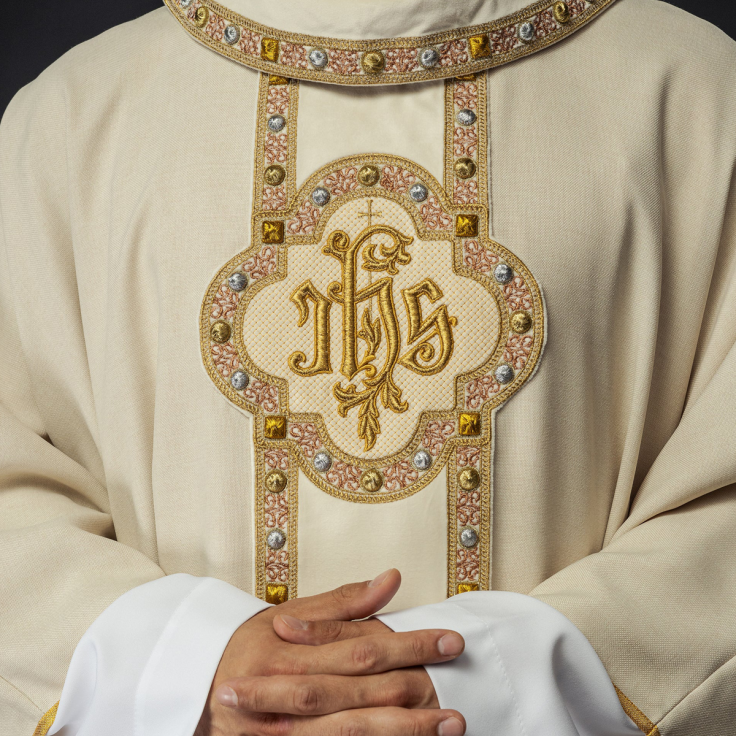Symbolism in Liturgical Vestments: Angelic Motifs and Their Spiritual Significance in Christian Worship
Explore how angelic symbols like wings and harps in liturgical vestments communicate faith, enhance sacred tradition, and deepen spiritual connection during worship

Liturgical vestments are not mere garments but true instruments of visual communication. Every colour, shape, and motif present on these vestments has a specific meaning, contributing to conveying a spiritual message to the faithful. Symbols, in particular, play a crucial role as they evoke concepts and ideas that go beyond simple visual representation. They recall biblical stories, theological virtues, and sacred figures, enriching the experience of the liturgy and fostering inner reflection.
The use of symbols in liturgical vestments is rooted in Christian tradition, which has used images and allegories to communicate faith since its origins. Over the centuries, this tradition has evolved, giving rise to a rich repertoire of symbols, each with its specific meaning. The choice of symbols to use in liturgical vestments is, therefore, a deliberate act that considers the liturgical context, the message to be conveyed, and the sensibilities of the faithful.
The Meaning of Angels in Christian Tradition
Angels, celestial figures present in many religious traditions, occupy a prominent place in Christian theology. They are considered messengers of God, intermediaries between heaven and earth, and guardians of men. The Bible is rich in references to angels, who appear at crucial moments in the history of salvation, announcing births, protecting the righteous, and guiding people.
In Christian tradition, angels are often represented with wings, a symbol of their ability to fly between heaven and earth, and with harps, a musical instrument that evokes praise and adoration to God. These iconographic representations have become an integral part of the Christian imagination, influencing art, literature, and music. The presence of angels in liturgical vestments, therefore, recalls their function as intermediaries between God and men and invites the faithful to elevate their spirit towards heaven.
Wings as a Symbol of Protection and Transcendence
Wings are one of the most widespread symbols in the representation of angels. They evoke the ability to fly, to rise above earthly limitations, and to reach the celestial dimension. Wings also symbolize the protection, help, and guidance that angels offer to men. The image of angels protecting the righteous under their wings is present in many passages of the Bible and in Christian tradition.
In liturgical vestments, wings can be represented in various ways, depending on the style and historical period. They can be stylised or realistic, coloured or monochrome, simple or elaborate. Regardless of their form, wings on liturgical vestments recall the presence of guardian angels, who watch over the faithful and protect them from dangers. They also invite one to transcend earthly concerns and focus on the spiritual dimension of life.
The Harp as an Instrument of Praise and Celestial Harmony
The harp is a musical instrument associated with celestial music, praise, and divine harmony. In the Bible, the harp is often played by angels to accompany songs of praise to God. The image of angels playing the harp is, therefore, a symbol of joy, harmony, and communion with the divine.
In liturgical vestments, the harp can be represented as a real instrument or in a stylised form, as a set of curved lines that evoke its shape. The presence of the harp on liturgical vestments recalls celestial music, praise to God, and the harmony that reigns in heaven. It invites the faithful to join the chorus of angels in divine praise, opening their hearts to joy and hope.
Examples of Angelic Motifs in Liturgical Vestments
Angelic motifs, with their wings and harps, are present in many liturgical vestments, both ancient and modern. For example, one can find ornaments with angels playing the harp, stylised wings adorning stoles, or embroideries with angelic figures protecting the Virgin Mary. These motifs, made with various techniques and materials, enrich the beauty and spirituality of liturgical vestments, contributing to creating an atmosphere of sacredness and devotion.
How to Choose a Liturgical Vestment with Angelic Motifs
The choice of a liturgical vestment with angelic motifs depends on several factors, including the liturgical context, the message to be conveyed, and one's personal sensibilities. It is important to choose an ornament that harmonises with the rest of the sacred furnishings and contributes to creating an atmosphere of sacredness and devotion.
The Importance of Care and Preservation of Liturgical Vestments
Liturgical vestments are precious objects, both from a material and spiritual point of view. It is, therefore, important to take care of them and preserve them properly to maintain their beauty and functionality over time. The care of liturgical vestments includes cleaning, ironing, repair, and storage in suitable places.
Conclusion: Angelic Motifs as an Expression of Faith and Beauty
Angelic motifs on liturgical vestments, with their wings and harps, represent an expression of faith and beauty that enriches the experience of the liturgy and invites the faithful to elevate their spirit towards heaven. These symbols, rooted in Christian tradition, evoke the divine presence, the protection of guardian angels, and celestial harmony. The choice of a liturgical vestment with angelic motifs is a deliberate act that considers the liturgical context, the message to be conveyed, and one's sensibilities.
HaftinaUSA.com offers a wide selection of liturgical vestments with angelic motifs, suitable for various occasions and tastes. They have a team of experts available to provide advice and suggestions, helping you choose the liturgical vestment that best suits your needs. As liturgical vestments are important in the celebration of faith, the company is committed to offering high-quality products that can convey a spiritual message and enrich the experience of the liturgy.
© Copyright IBTimes 2025. All rights reserved.





















